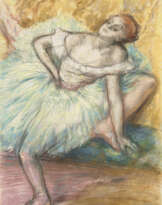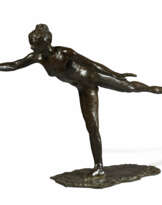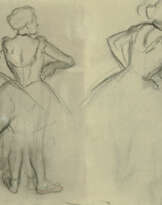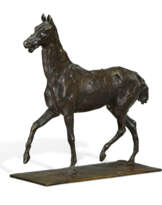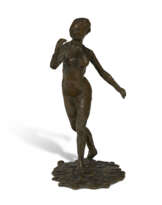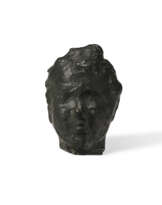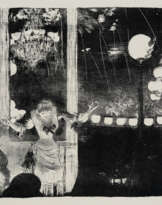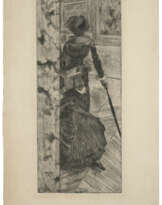ID 1051695
Lot 128 | Edgar Degas (1834-1917)
Estimate value
€ 150 000 – 250 000
La sortie du bain
pointe-sèche et aquatinte
Plaque: 12.6 x 13.7 cm.
Feuille: 23.5 x 18.2 cm.
Exécutée en 1882, superbe épreuve, richement encrée, seule épreuve connue du dix-huitième état sur vingt-deux, comme décrit par Reed & Shapiro
drypoint and aquatint, on wove paper
Plate: 5 x 5 3⁄8 in.
Sheet: 9 ¼ x 7 1⁄8 in.
Executed in 1882, a superb impression with rich burr, the only known example of Reed & Shapiro's eighteenth state (of twenty two)
Provenance
Atelier de l'artiste.
Sam Josefowitz, Pully (en 1984).
Puis par descendance aux propriétaires actuels.
Literature
L. Delteil, Le Peintre-Graveur illustré, Degas, New York, 1968, vol. IX, no. 39 (un autre état illustré).
J. Adhemar, F. Cachin, The complete etchings, lithographs and monotypes, Londres, 1974, no. 49.a (une autre épreuve illustrée).
Japonisme, Japanese Influence on French Art 1854-1910, cat. exp., The Cleveland Museum of Art, The Rutgers University Art Gallery and The Walters Art Gallery, Cleveland, 1975, p. 48, no. 55 (un autre état illustré).
B. S. Shapiro, S. W. Reed, Edgar Degas: The Painter as Printmaker, cat. exp., Boston, Museum of Fine Arts, Philadelphia Museum of Art, London, Hayward Gallery, Boston, Philadelphia et London, 1984, p. 124-140, no. 42.xviii (illustrée, p. 138).
S. Lees, R. R. Brettell, Innovative Impressions, Prints by Cassatt, Degas and Pissarro, cat. ex., Tulsa, Oklahoma, juin -septembre, 2018, p. 52-53 (autres états illustrés).
Exhibited
Boston, Museum of Fine Arts, Boston; Philadelphia Museum of Art; London, Arts Council of Great Britain; Hayward Gallery, Edgar Degas: The Painter as Printmaker, novembre 1984-juillet 1985, p. 125, no. 42.xviii (illustrée, p. 138).
Paris, Galeries Nationales du Grand Palais; Ottawa, National Gallery of Canada; New York, Metropolitan Museum of Art, Degas, Paris, Ottawa, New York, 1988-89, p. 305, no. 194. (illustrée, p. 306).
Liverpool, Tate Gallery, Degas Images of Women, septembre-decembre 1989, p. 60, no. 37 (illustrée).
Vevey, Cabinet cantonal des estampes; Quebec, Musée du Québec, Jerusalem, The Israel Museum, Degas & Pissarro: alchimie d'une rencontre, août 1998-octobre 1999, p. 79, no. 57 (illustrée p. 81).
Further details
Selon une anecdote rapportée par le collectionneur et ami de l'artiste Alexis Rouart, Degas commença cette importante gravure après avoir été contraint de passer la nuit chez son ami en raison d'un temps glacial. Le lendemain matin, il demande une plaque de cuivre et esquisse le premier état de La sortie du bain. Alors qu'il établit rapidement les éléments essentiels, la femme sortant du bain avec une servante tenant une serviette pour la recevoir, Degas continue à développer la composition par une série de modifications et d'ajustements mineurs dans un total de vingt-deux états, le plus grand nombre de toutes ses estampes. Ce qui est le plus remarquable dans les vingt-deux états de cette image, c'est le flux et le reflux de la lumière et de l'obscurité lorsque Degas a continué à travailler sur cette plaque, non seulement en ajoutant des lignes et des passages d'aquatinte, mais aussi en brûlant à plusieurs reprises certaines zones, puis en y ajoutant des lignes et des tons" (S. Lees, R. R. Brettell, op. cit., p. 49 et 52).
Ces changements souvent subtils comprennent l'ajout de motifs sur les murs, le tapis et le fauteuil au premier plan. Cette impression unique du dix-huitième état, largement exposée, est peut-être la plus articulée des vingt-deux états, chaque élément individuel étant défini avec plus de clarté. Les ondulations de l'eau du bain ont été délicatement suggérées à la pointe sèche, et les formes du fauteuil à l'arrière-plan et de la cheminée à droite sont plus clairement discernables de l'intérieur riche en motifs, tout comme la figure de la baigneuse, maintenant éclaircie par le brunissage pour créer l'effet doux de la lumière d'une lampe sur la peau.
According to an anecdote recounted by the collector and friend of the artist Alexis Rouart, Degas began this important etching after being compelled to stay the night at his friend’s home due to freezing weather. compelled to stay the night at his friend’s home due to freezing weather. The next morning he requested a copper plate and sketched the first state of Le sortie du bain. While he quickly established the essential elements, the woman getting out of the bath with a servant holding a towel to receive her, Degas continued to develop the composition through a series of minor alterations and adjustments in a total of twenty-two states, the largest number of any of his prints. ‘What is most remarkable about the twenty-two states of this image is the ebb and flow of light and dark as Degas continued to work on this plate, not only adding lines and…passages of aquatint, but also repeatedly burnishing out certain areas and then adding lines and tones back into them’ (S. Lees, R. R. Brettell, op. cit., p. 49 and 52).
These often subtle changes include the addition of patterns to the walls, rug, and armchair in the foreground. This widely exhibited unique impression of the eighteenth state is perhaps the most articulate of the twenty-two states, with each individual component defined with greater clarity. The ripples of the water in the bath have been delicately suggested with drypoint, and the shapes of the armchair in the background and the mantlepiece at right are more clearly discernible from the heavily patterned interior, as is the figure of the bather, now lightened with burnishing to create the soft effect of light on the bather’s skin.
| Artist: | Edgar Degas (1834 - 1917) |
|---|---|
| Applied technique: | Aquatint, Drypoint |
| Medium: | Acrylic glass, Plastic |
| Place of origin: | Western Europe, France, Europe |
| Artist: | Edgar Degas (1834 - 1917) |
|---|---|
| Applied technique: | Aquatint, Drypoint |
| Medium: | Acrylic glass, Plastic |
| Place of origin: | Western Europe, France, Europe |
| Address of auction |
CHRISTIE'S 9 Avenue Matignon 75008 Paris France | ||||||||||||||
|---|---|---|---|---|---|---|---|---|---|---|---|---|---|---|---|
| Preview |
| ||||||||||||||
| Phone | +33 (0)1 40 76 85 85 | ||||||||||||||
| Fax | +33 (0)1 40 76 85 86 | ||||||||||||||
| Conditions of purchase | Conditions of purchase | ||||||||||||||
| Shipping |
Postal service Courier service pickup by yourself | ||||||||||||||
| Payment methods |
Wire Transfer | ||||||||||||||
| Business hours | Business hours
|





